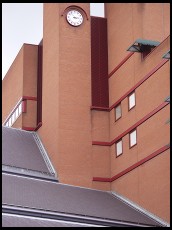
Olympus E-10
by Philip Greenspun; created 2001
Site Home : Photography : Olympus E-10

The Olympus E-10 is a digital camera for photographers who want the creative control, fast operation, and effective viewfinder of a digital SLR but without the weight and complexity of an interchangeable lens system.
The camera's CCD sensor is quite a bit smaller than the standard 24x36mm frame of a 35mm camera. With the Nikon and Canon system digital SLRs, this means that you're lugging around a lens that is twice as heavy, bulky, and expensive as it needs to be. With the Olympus E-10 it means that they simply designed a zoom lens that projects a large enough image circle to cover the sensor (just barely). The 9-36mm zoom lens gives the equivalent perspective of a 35-140mm zoom on a 35mm camera.
The viewfinder has the adequate eye relief, i.e., an eyeglass wearer can see the entire image and the shutter speed/aperture display just underneath. The image is a bit dim but, strangely, gets brighter after turning the camera on. The Olympus E-10 is a single-lens reflex (SLR) camera. The imaging sensor and the viewfinder are getting light from the same lens. However, unlike the typical SLR, the Olympus does not have a mirror that flips up and out of the way during exposure. A permanent beam-splitting prism is in the imaging path. This means that the viewfinder receives only a fraction of the light from the lens during image composition and the image sensor receives only a fraction of the light during exposure. So the f/2.0 maximum aperture of the lens might be equivalent to f/2.5 on an SLR with a mirror.
This is a 4-megapixel camera, producing an image 2240x1680 in size. The images are 8 bits deep when producing standard JPEGs (1.3 MB each), 10 bits deep when storing RAW images (3.4 MB each). Resolution isn't everything, as you can see for yourself by looking at the quality of the pixels in full-resolution JPEGs coming out of the Canon S100, G1, and D30 cameras then the E-10 underneath:
To my eyes, the raw pixels from the D30 and the E-10 are sharper and clearer than the point-and-shoot raw pixels.
Contrasty scenes quickly overwhelm the standard 8 bits of the JPEGs. At right, for example, is a photograph of a street fountain in Barcelona. Notice how the details of the buildings are washed out when we've given enough exposure for the dark metal of the fountain. This would have been a good time to use the RAW mode. Unfortunately the RAW images have to be manually processed with Olympus-supplied software, whereas JPEGs can be batch-processed with ImageMagick (the way that we've done the 10,000 or so images on this site; see http://philip.greenspun.com/panda/images for background on this subject). Below is a couple more Barcelona scenes, the Parc Guell and the Richard Meier modern art museum, that suffer from the 8-bit limitation of the JPEG. If you'd taken these photos with color negative film, a machine print might look similar to what you see below but a custom print or a little work in Adobe PhotoShop would be able to restore the the lost detail. If you originate 8-bit JPEGs in a digital camera, though, the detail is lost forever.
The E-10 has an adjustable contrast setting but it is virtually impossible to use in practice because (a) it requires going through menus to set, and (b) the LCD displays don't make it easy to figure out what the camera is doing at exposure time.
The E-10's imaging sensor is much smaller than the chips in professional digital SLRs such the Nikon D1, Canon D30, and Fuji S1. In general, small sensor = noisy. The E-10 is no exception to this rule. Noise is acceptable with the camera set to ISO 80 but becomes obtrusive at ISO 160 and ISO 320 (the other two possible settings). At right is an image of the Olympic radio tower at Barcelona's stadium. The sensor speed was mistakenly left on 320. Notice the heavy grain in the sky. If you want to capture the magic of available light, gird yourself with a professional SLR and an f/1.4 or f/1.8 lens.

Having just finished a review of the Canon D30, my overwhelming impression of the E-10 was its sluggishness. The camera is slow to wake up. The camera is slow to complete image processing following an exposure. Want to view an image that you've just exposed? Turn the control dial to the playback mode. Something catches your eye for a new photo? Bring the camera up to your face and press the shutter release. Nothing happens. Keep pressing. Nothing happens. Kick yourself for forgetting to switch the control dial back to one of the image-creation modes.
Aside from sluggishness, the other glaring user interface anomaly for a professional photographer is that metering hints and exposure compensation settings are expressed numerically rather than graphically. For example, if you're in manual exposure mode and you've set the camera 2/3 stop over the meter's recommendation, you'll see a "+0.7" in the viewfinder LCD. Suppose you're in autoexposure mode and are metering off some snow that you want to appear white in the final image rather than gray. You set exposure compensation of 1 f-stop overexposure. The camera reads "+1.0". Compared to the large analog needles of 1970s SLRs and the LCD graphs of modern SLRs, this is a decidedly slower and less intuitive way of representing exposure.
One nice thing about the E-10 is that it has two control wheels. In manual exposure mode, shutter speed is set with the finger wheel by the shutter release while aperture is controlled by the thumbwheel on the back of the camera. In autoexposure mode, the priority setting (aperture or shutter speed) is set with the finger wheel. Olympus had an opportunity to let you set exposure compensation with the rear control dial. Instead, the rear dial merely duplicates the function of the front dial.
Missing features? The camera has no depth-of-field preview button. There is no "panoramic assist" mode that is standard on point-and-shoot style digital cameras. You can still stitch together photos after the fact but you'll probably have to use a tripod to keep the horizon level.
Unexpected features? Unlike a traditional single-lens reflex, the E-10 does not have a mirror. So the sensor is receiving light from the lens at all times. This means that you can have a point-and-shoot style real-time image preview on the rear LCD monitor.
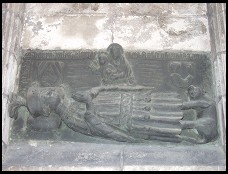
The E-10 has a flip-up built-in flash of modest power. It almost but not quite rises high enough to avoid casting a shadow with the plastic lens hood at the widest zoom setting (i.e., remember to remove the hood when using the flash or set the lens to a normal or telephoto perspective).
The E-10 accepts accessory flashes in a hot shoe, and has a PC sync cord on the left side of the body for use with studio strobes.
The photo at right illustrates the limitations of on-camera flash in any case. It is a wall relief in the cloister of Barcelona's cathedral. Notice how the shape of the sculpture is almost impossible to discern because the light is coming from directly behind the viewpoint.
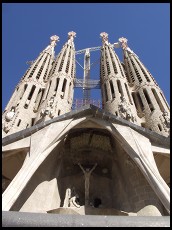
The standard camera will take 4 AA batteries. Fresh alkalines give the camera enough juice for about ... 4 pictures! Don't even try. The custom-sized Olympus disposable lithium batteries are good for about 250 pictures. A pair will cost $20 and can only be purchased at camera shops that sell Olympus digital cameras.
For heavy users, we recommend purchasing the B-30LPS vertical grip and rechargeable battery kit ($500). This gives you a lithium polymer battery of formidable power.
As with every other digital camera we've tested, the Olympus E-10 it does not understand when it is being held vertically. Thus all the portrait-format JPEGs, once transferred into a computer, are incorrectly oriented. You have to work through the images manually in some kind of desktop application, manually rotating all the pictures that you took while holding the camera vertically. Thus does human labor substitute for Olympus's omission of a 50-cent mercury switch.
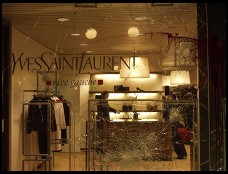
The E-10 is not clever about switching ISO speeds when in "auto" mode. If, however, the light gets a bit dim and you switch manually to the maximum ISO 320 speed, you'll probably forget to switch back when you're in the sun again. Why? The Olympus does not display in any of its LCDs the ISO setting. You have to explicitly press the setup menu button to check the ISO setting. By contrast the Canon D30 shows the ISO setting at all times and a custom function setting lets you quickly adjust it without going through any menus.
It would be nice to have a 100% viewfinder. With a film camera there are a lot of ways to lose the edges of the frame: to a slide mount, masked off in printing, masked off in scanning. With a digital camera, what you capture is what you present, unless you want to go into an image editing program and laboriously crop. So the viewfinder really ought to be 100%.

A digital SLR with interchangeable lenses has a hidden liability: dust. If you can change the lens, you can open the camera to the dusty world. With a film camera, this isn't such a big deal because with every frame a fresh clean sensor (a piece of film) comes out of the factory-sealed film canister. With a digital camera, a speck of dust that lands on the imaging sensor will mar every photo that you take for months unless you (1) notice, and (2) flip up the mirror and blow the dust off. The Olympus E-10 sidesteps this problem with the simple expedient of gluing the lens permanently to the camera!
[See this Nikon D1 review for a horrific dust-on-sensor story.]
The Olympus E-10 has some of the same advantages of the professional digital SLRs cameras: big and accurate viewfinder so that you can see what you are photographing, fast autofocus, ability to capture action because there is little shutter lag, and high image quality. Yet it is less than half the size, weight, and bulk of a system digital SLR plus lens. This makes the E-10 perfect for parents who want to capture their kids at sporting events. It is also a very good travel camera. Bird and wildlife enthusiasts will appreciate the E-10 plus the screw-in converter that increases the optical system's magnification to the equivalent of a 420mm telephoto lens on a 35mm camera.
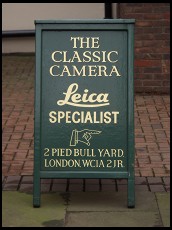
One nice thing about the E-10 is how the ownership experience can be similar to that of a film camera. You can leave it on the shelf for 6 months with a big flash card and the disposable lithium batteries installed. If a photographic situation arises, just grab the camera and run out the door. You can be sure that the batteries will work, that you didn't forget any required accessories, and if the flash card is large enough you won't have to worry about spares.
If you already have a collection of Canon or Nikon lenses and are intent on using a digital SLR as a tool, you'll probably be happier with the Canon D30 or Nikon D1. These cameras have the user interface that you expect, are capable of higher image quality in many situations, and can be used for specialized assignments with macro lenses, supertelephotos, and extreme wide angle lenses.
The 35mm perspective of the E-10's zoom isn't really wide enough for comfort in old European cities. However, the long end of the lens is fun for compressing image elements and for isolating details:
Text and photos copyright 2001 Philip Greenspun.